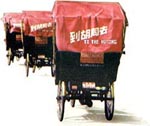|

When you hear the word rickshaw, you may think of the two wheeled carts pulled around by chinese guys with long braids that you see in old movies. But today, rickshaws are actually three wheeled bicycles often driven by old, retired men. There are fleets of them circling around the TianAnMen square area, and they are always willing to take passengers. It is nice to take a ride around the square in the evening, but if you do, make sure you come to a price agreement first. There are many con-men out there, and you have to be firm and clear about your price.
Where to take rickshaw tour
The most popular place is from TianAnMen square area, the other area to take rickshaw rides is by the north gate of Beijing Park. This is the beijing hutong ( alleyway ) tour, in which you will by full 200 meters west, and when you see a long line of rickshaws that are identical, you are there.
Stories of Hutong
One of the unique features of Beijing is its numerous Hutongs which means small lanes. The life of ordinary people in these lanes contributes greatly to the charm of this ancient capital. In these small lanes, you'll find many siheyuan, or quadrangles which are the living quarters of ordinary Beijingers. No one knows exactly how many lanes there are in Beijing which has been China's capital for five dynasties. But one thing is certain, if we connected all these lanes, their total length would be longer than the famous Great Wall, which is more than 6,000 kilometer' long.
Why are Beijing's lanes called Hutong: According to historical records, a small scall scale city first appeared in the Beijing area about 3,000 years ago. It was not until the Jin dynasty in the 12 century that Beijing became the capital city for the first time. At that time, there were no Hutongs in Beijing, just streets and roads. The word "Hutong" is said to originate from the Mongolian language which is one of China's minority language. It means a passage between rows of Siheyuan courtyard house, the traditional residence of Beijingers, each consisting of rectangle courtyard surrounded by one-storeyed tile-roofed houses, usually one to six meters wide, hutongs are where life was going on for the last 700 years since they first appeared in the Yuan Dynasty (1271-1368).
In the early 13 century, a Mongolian tribe from the north became very strong. Led by Genghis Khan, the Mongolians occupied Beijing, then the capital of the Jin. In 1260, Kubla Khan, the grandson of Genghis Khan established Yuan Dynasty. Kubla Khan set Beijing as the capital city. Unfortunately, the old city was destroyed during the war. So they had to rebuild it. In old China, all the structures and roads were required to be symmetrical. So the city was well designed.
First, they had to find a centre, and then built a regular square city. After construction was completed, they asked all the residents who lived in the old city to move to the new one. In this newly-built city, you can find streets and Hutongs. At that time, there was a clear definition for a street or a lane. A 36-metre-wide road was called a big street. An 18-metre-wide one was called a small street. And a 9-metre-wide lane was called a Hutong.
How to book?
Sinoway Travel offer 'Add-on Activities' per day.
Price per person: USD 30
Time: 09h30 - 11:30 or 14h30 - 16:30
Include: round trip transfer hotel/attractions, English translation service
Contact us to book this add-on activities.
|
|